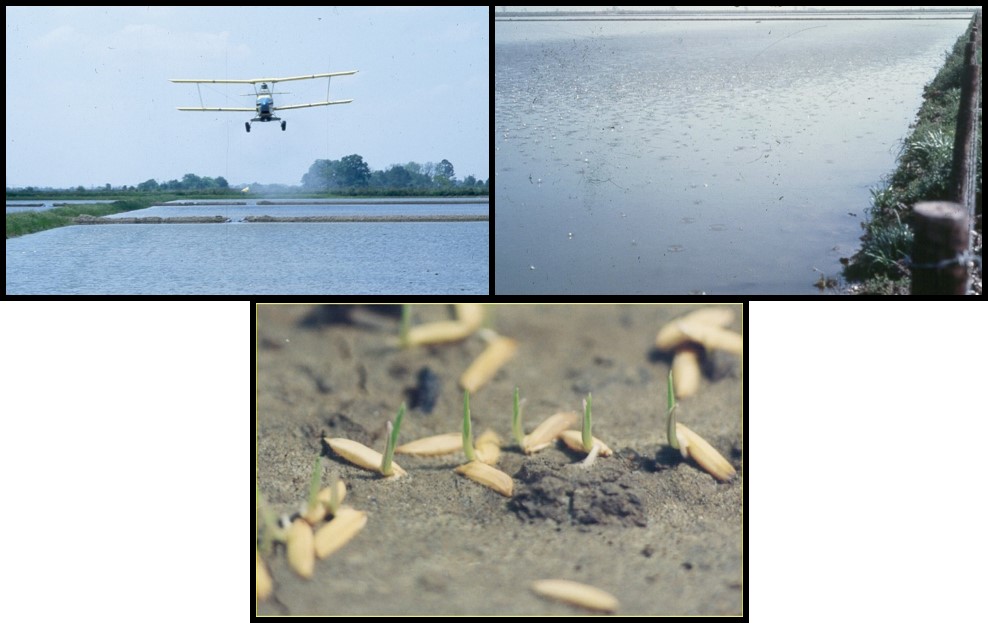Weed Control in Water-Seeded Rice
Weed Control in Water-Seeded Rice
Heavy and relentless rainfall this spring has led to interest in water-seeding rice. This method can be an effective seeding strategy (Fig. 1); however, weed control becomes a bit more challenging, especially with residual herbicides and their potential to cause crop injury. If considering water-seeding rice, here are some weed control recommendations specific to water-seeding.
 |
Fig. 1. Water-seeding of rice. Photos courtesy of Dr. Eric Webster, Louisiana State University Ag Center. |
Starting clean is critical in a water-seeded system to help maintain weed control until postemergence applications can be made. If Command is applied preplant (prior to flood), it can be tank-mixed with Roundup to effectively kill any emerged weeds and make sure the field begins clean. However, be aware of surrounding areas to mitigate drift of Roundup onto a neighboring susceptible crop, specifically emerged rice.
The biggest challenge with weed control in water-seeded rice is residual herbicide options. Prowl is not an option as severe rice injury may occur due to exposed roots as a result of the water-seeding method (the mode-of-action for Prowl is a seedling root growth inhibitor). Bolero can be used successfully, but requires very specific application conditions. It can be applied preplant to a dry seed bed with flood establishment 2 to 3 days after application. Rice seeding then should not occur until 24 hours after the flood is stabilized, and rice seed should be presoaked. All of this is not a very viable option with our current conditions. Bolero can also be applied postemergence to moist soil or in a flood; however rice must be at least at the 2-leaf stage which leaves an open window for weeds to germinate prior to its application. Sharpen is an option to be applied prior to flood and seeding, but is primarily used for broadleaf weeds like pigweed and does not provide grass control. Overall, Command is the best and most viable option for water-seeded rice in Arkansas, especially given our current conditions. Command can be applied preplant (prior to flood establishment) or at pegging stage to one-leaf rice when the flood has been drained for seed set. There is a higher potential for rice injury when applied preplant, but typically it isn’t severe enough to affect yield. As a result of the limited options for residual herbicides, it is a must to be timely with postemergence applications to effectively manage weeds.
Many postemergence herbicides have specific restrictions on when they can be applied in water-seeded systems, and it is critical to keep a watchful eye on fields to make timely and effective applications. Gambit is one of the most flexible options as it can be applied from preplant to post-flood. One note with water-seeded rice, however, is if Gambit is applied in flood, floodwater must be held for at least 14 days, making this a more viable option after pegging. Grasp can be applied at pegging if no roots are exposed, but fields must be at least partially drained prior to application. Strada and Loyant can be applied when rice reaches the 2 leaf stage with no exposed roots, but again fields must be partially drained. Ricestar HT and Provisia (Provisia rice) each require 2 leaf rice before applications can be made. Fields do not specifically need to be drained for Ricestar HT or Provisia, but good weed coverage/leaf contact is needed.
Facet, Grandstand, and Regiment all require at least 3 leaf rice in water-seeded systems as significant crop injury can occur if applied earlier. In a Clearfield system, Newpath can be applied preflood or at pegging when there is no standing water in the field, and Beyond can be applied post-flood for additional grass control. For more in-depth details regarding specific herbicide usage in a water-seeded system, please refer to the herbicide label.
To provide more postemergence herbicide options and create greater flexibility within the limited windows for applications, our recommendation is to use a Clearfield rice variety for a water-seeded rice system. Apply Command (or Command plus Roundup) preplant and Newpath at pegging to overlap residual chemistries for grass control. After the pegging application, postemergence herbicides can be selected and applied based on need, appropriate timings, and weed species.
A final piece of advice from Dr. Eric Webster at the Louisiana State University Ag Center: “Command is your best-friend in a water-seeded system as an upfront residual, so make sure that application is made either preemergence or at pegging with first leaf out of the water. After seeding, get the water off as soon as possible to allow for pegging and then just stay away and let it establish! Come back at the 2-3 leaf stage of rice and start with timely postemergence applications”.
For additional information regarding water-seeded rice weed control, please see the MP44, Recommended Chemicals for Weed and Brush Control (http://bit.ly/UAEX_MP44) (Fig. 2) or the MP192, Rice Production Handbook (http://bit.ly/UAEX_MP192) (Fig. 3).
 Fig. 3. Please scan the QR code above to download a copy of the MP192, Rice Production Handbook.
Fig. 3. Please scan the QR code above to download a copy of the MP192, Rice Production Handbook. Fig. 2. Please scan the QR code above to download a copy of the MP44, Recommended Chemicals
for Weed and Brush Control.
Fig. 2. Please scan the QR code above to download a copy of the MP44, Recommended Chemicals
for Weed and Brush Control.